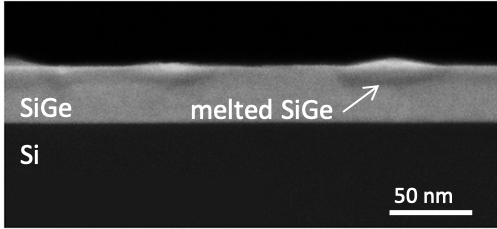

Work package 2 focuses on fabrication technology processes related to dopant implantation and activation, solid phase epitaxial regrowth and silicidation of metal contacts. Through a better understanding of these processes at the atomic scale, we aim to improve the predictivity of classical models and also to develop new state-of-the-art modelling tools more appropriate regarding the constraints imposed by the nanosized SiGe based devices and very low temperature processes.
The scope of WP2 will therefore be to achieve advanced models according to two actions:
Advanced calibration of lattice kinetic Monte Carlo (LKMC) models. In particular, the aim will be to review the set of calibration parameters with an accurate atomistic description in SiGe. During implantation, the model in which the thermal vibrations in the lattice will be introduced, will be able to capture both the effects of deformation generated by damage accumulation, the amorphization depths and the remaining damage. In the case of SPER in particular for heavily doped SiGe, several dependencies exist: the enhancement and retardation of recrystallisation by dopants, as well as the snow-plowing and clustering of dopants at the amorphous/crystalline interface, the influence of crystal orientation and strain dependence, but also the regrowth of defects need to be addressed together.
Develop a new formalism for LKMC models to accurately and efficiently handle the silicidation process. The simulation of silicidation is one of the most challenging tasks of the project as we have to describe multiple structural transitions due to the sequence of several alloys formed as the deposition occurs. The new model capable of simulating both intermixing reactions and diffusion reactions at the different interfaces allows us to understand the interface effects and phase transformation at the interface.
These achievements will be possible through a close discussion between simulations and experimental results.
WP2 coordinator: Anne Hemeryck, LAAS-CNRS
Selected publications
C. Jara Donoso, A. Jay, J. Lam, J. Muller, G. Larrieu, G. Landa, C. Bongiorno, A. La Magna, A. Alberti, A. Hemeryck
A Comprehensive Atomistic Picture of the As-deposited Ni-Si Interface Before Thermal Silicidation Process
Applied Surface Science 631 (2023) 157563 Download
P.L. Julliard, A. Johnsson, N. Zographos, R. Demoulin, R. Monflier, A. Jay, O. Er-Riyahi, F. Monsieur, S. Joblot, F. Deprat, D. Rideau, P. Pichler, A. Hemeryck, F. Cristiano
Prediction of the Evolution of Defects Induced by the Heated Implantation Process: Contribution of Kinetic Monte Carlo in a Multi-scale Modeling Framework
Solid-State Electronics 200 (2023) 108521 Download
A. Johnsson
On Continuum Simulations of the Evolution of Faulted and Perfect Dislocation Loops in Silicon during Post-implantation Annealing
MRS Advances 7 (2022) 1315 Download
 Modeling Unconventional Nanoscaled Device FABrication
Modeling Unconventional Nanoscaled Device FABrication